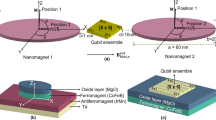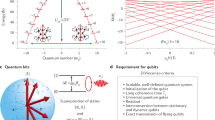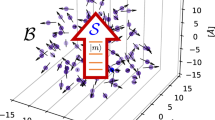Abstract
The erasure of a bit of information is an irreversible operation whose minimal entropy production of kB ln 2 is set by the Landauer limit1. This limit has been verified in a variety of classical systems, including particles in traps2,3 and nanomagnets4. Here, we extend it to the quantum realm by using a crystal of molecular nanomagnets as a quantum spin memory and showing that its erasure is still governed by the Landauer principle. In contrast to classical systems, maximal energy efficiency is achieved while preserving fast operation owing to its high-speed spin dynamics. The performance of our spin register in terms of energy–time cost is orders of magnitude better than existing memory devices to date. The result shows that thermodynamics sets a limit on the energy cost of certain quantum operations and illustrates a way to enhance classical computations by using a quantum system.
This is a preview of subscription content, access via your institution
Access options
Access Nature and 54 other Nature Portfolio journals
Get Nature+, our best-value online-access subscription
$29.99 / 30 days
cancel any time
Subscribe to this journal
Receive 12 print issues and online access
$209.00 per year
only $17.42 per issue
Buy this article
- Purchase on Springer Link
- Instant access to full article PDF
Prices may be subject to local taxes which are calculated during checkout




Similar content being viewed by others
Change history
20 April 2018
In the version of this Letter originally published, the key to the green and open circles in Fig. 4 was reversed; it should have shown that the green circles correspond to ‘From χ versus T’ and the open circles correspond to ‘From χ versus Hy’. This has now been corrected in all versions of the Letter.
References
Landauer, R. Irreversibility and heat generation in the computing process. IBM J. Res. Dev. 5, 183–191 (1961).
Jun, Y., Gavrilov, M. & Bechhoefer, J. High-precision test of Landauer’s principle in a feedback trap. Phys. Rev. Lett. 113, 190601–190605 (2014).
Berut, A. et al. Experimental verification of Landauer’s principle linking information and thermodynamics. Nature 483, 187–189 (2012).
Hong, J., Lambson, B., Dhuey, S. & Bokor, J. Experimental test of Landauer’s principle in single-bit operations on nanomagnetic memory bits. Sci. Adv. 2, 1501492–1501497 (2016).
Boechler, G. P., Whitney, J. M., Lent, C. S., Orlov, A. O. & Snider, G. L. Fundamental limits of energy dissipation in charge-based computing. Appl. Phys. Lett. 97, 103502–103504 (2010).
Lambson, B., Carlton, D. & Bokor, J. Exploring the thermodynamic limits of computation in integrated systems: Magnetic memory, nanomagnetic logic, and the Landauer limit. Phys. Rev. Lett. 107, 010604–010607 (2011).
Gammaitoni, L., Chiuchiu, D., Madami, M. & Carlotti, G. Towards zero-power ICT. Nanotechnology 26, 222001–222010 (2015).
Bennett, C. H. The thermodynamics of computation - a review. Int. J. Theor. Phys. 21, 905–940 (1982).
Gerrits, T., van den Berg, H. A. M., Hohlfeld, J., Bar, L. & Rasing, T. Ultrafast precessional magnetization reversal by picosecond magnetic field pulse shaping. Nature 418, 509–512 (2002).
Žutić, I., Fabian, J. & Das Sarma, S. Spintronics: fundamentals and applications. Rev. Mod. Phys. 76, 323–410 (2004).
Ostler, T. A. et al. Ultrafast heating as a sufficient stimulus for magnetization reversal in a ferrimagnet. Nat. Commun. 3, 666–671 (2012).
Yang, Y. et al. Ultrafast magnetization reversal by picosecond electrical pulses. Sci. Adv. 3, 1603117–1603122 (2017).
Lloyd, S. Quantum-mechanical Maxwell’s demon. Phys. Rev. A 56, 3374–3382 (1997).
Lesovik, G., Lebedev, A., Sadovskyy, I., Suslov, M. & Vinokur, V. H-theorem in quantum physics. Sci. Rep. 6, 32815–32821 (2016).
Gatteschi, D., Sessoli, R. & Villain, J. Molecular Nanomagnets Vol. 5 (Oxford Univ. Press, Oxford, 2006).
Wernsdorfer, W. & Sessoli, R. Quantum phase interference and parity effects in magnetic molecular clusters. Science 284, 133–135 (1999).
Sangregorio, C., Ohm, T., Paulsen, C., Sessoli, R. & Gatteschi, D. Quantum tunneling of the magnetization in an iron cluster nanomagnet. Phys. Rev. Lett. 78, 4645–4648 (1997).
Burzurì, E. et al. Quantum interference oscillations of the superparamagnetic blocking in an Fe8 molecular nanomagnet. Phys. Rev. Lett 111, 057201–057205 (2013).
Burzurì, E. et al. Magnetic dipolar ordering and quantum phase transition in an Fe8 molecular magnet . Phys. Rev. Lett 107, 097203–097206 (2011).
Luis, F., Bartolomé, J. & Fernández, J. F. Resonant magnetic quantum tunneling through thermally activated states. Phys. Rev. B 57, 505–513 (1998).
Garanin, Da & Chudnovsky, E. M. Thermally activated resonant magnetization tunneling in molecular magnets: Mn12Ac and others. Phys. Rev. B 56, 11102–11118 (1998).
Leuenberger, M. N. & Loss, D. Spin relaxation in Mn12-acetate. Europhys. Lett. 46, 692–698 (1999).
Margolus, N. & Levitin, L. B. The maximum speed of dynamical evolution. Physica D 120, 188–195 (1998).
Lloyd, S. Ultimate physical limits to computation. Nature 406, 1047–1054 (2000).
Campbell, S. & Deffner, S. Trade-off between speed and cost in shortcuts to adiabaticity. Phys. Rev. Lett. 118, 100601–100607 (2017).
Acknowledgements
The research reported here was supported by an advanced ERC grant (Mols@Mols). We also acknowledge financial support by the Dutch Organization for Fundamental research (NWO/FOM). E.B. acknowledges funds from the EU FP7 programme through the project 618082 ACMOL. F.L. acknowledges the Spanish MINECO (grant MAT2015-68204-R), the Gobierno de Aragón (grant E98-MOLCHIP) and the European Union (COST 15128 Molecular Spintronics project). R.G. especially thanks L. Gammaitoni for inspiring discussions.
Author information
Authors and Affiliations
Contributions
R.G. conceived the idea; F.L., E.B. and R.G designed and performed the experiment; R.G., E.B., F.L. and H.S.J.v.d.Z. wrote the manuscript; S.M. synthesized the molecules. All authors contributed to the interpretation of the data and commented on the manuscript.
Corresponding author
Ethics declarations
Competing interests
The authors declare no competing interests.
Additional information
Publisher’s note: Springer Nature remains neutral with regard to jurisdictional claims in published maps and institutional affiliations.
Supplementary information
Supplementary Information
Supplementary notes, Supplementary Figures 1–12,Supplementary references
Rights and permissions
About this article
Cite this article
Gaudenzi, R., Burzurí, E., Maegawa, S. et al. Quantum Landauer erasure with a molecular nanomagnet. Nature Phys 14, 565–568 (2018). https://doi.org/10.1038/s41567-018-0070-7
Received:
Accepted:
Published:
Issue Date:
DOI: https://doi.org/10.1038/s41567-018-0070-7
This article is cited by
-
Fundamental energy cost of finite-time parallelizable computing
Nature Communications (2023)
-
Fluctuation relations for irreversible emergence of information
Scientific Reports (2022)
-
Breaking Landauer's bound in a spin-encoded quantum computer
Quantum Information Processing (2022)
-
Emergent Bioanalogous Properties of Blockchain-based Distributed Systems
Origins of Life and Evolution of Biospheres (2021)
-
Quantum hardware simulating four-dimensional inelastic neutron scattering
Nature Physics (2019)



